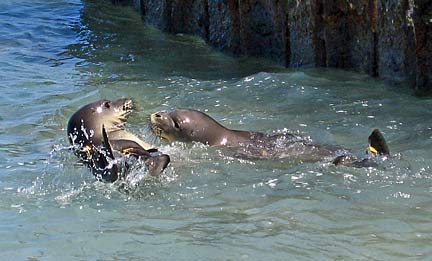
|
Starvation, sharks cut
monk seal population
Teachers aboard a research
ship learn to practice caution
|
ABOARD THE HI'IALAKAI » Hawaiian monk seal bodies are so well designed for their lives in the sea and on land that their skeletal structure hasn't changed in 15 million years.
|
|
The number of Hawaiian monk seals has been holding fairly stable at 1,300 animals since 1993.
But those who study the animals know that a dip in their numbers is coming, because not as many pups are making it through their crucial first few years of life, Canja told educators visiting Tern Island last week during their voyage to the Northwestern Hawaiian Islands on the National Oceanic and Atmospheric Administration research vessel Hi'ialakai.
Canja said starvation and sharks are two reasons why seals are not thriving.
Starvation can affect young seals when their mothers stop nursing early, which leaves pups undersized when they start hunting on their own, Canja said. The newly weaned seals must compete for their meals against full-grown seals, which have the advantage of weight and hunting experience.
Why some mothers are weaning their pups early is one of wildlife managers' worries, Canja said. Finding a solution to their slaughter by sharks is another.
Researchers witnessed a change in the behavior of Galapagos sharks that started preying on young seals at Trig Island, one of the most popular places for seals in French Frigate Shoals.
The problem started in 1997, when aggressive adult male seals killed as many as 16 young seals by holding them down in shallow water, said Dan Luers, head of the National Marine Fisheries Service's shark project. Two of those bully seals were moved to another location the following year, but another problem arose.
Galapagos sharks, which have always been at French Frigate Shoals in the Northwestern Hawaiian Islands, apparently found some of the monk seal carcasses, Luers said. In 1998, at least 17 seal pups, perhaps as many as 28, were attacked by sharks, and most of them died, he said.
Alarmed researchers began patrolling 12 hours a day in 1999 off islands where seals were being nabbed, Luers said, throwing rocks at sharks seen moving in on a pup.
But the carnage continued. So in 2000 the Fisheries Service started removing sharks identified as seal-killers --14 that year and five more in 2001, Luers said. The hope is that remaining sharks won't carry on the seal slaughter.
Some of the teachers from the Hi'ialakai expressed concern about the wisdom of killing one wild creature to preserve another.
It's a tough balancing act, Luers agreed. But seals are the endangered species.
French Frigate Shoals, about halfway up the Northwestern Hawaiian Islands, has the largest population of monk seals in the chain. However, in recent years more monk seals, up to 52, have been showing up around the main Hawaiian islands, leading wildlife managers to alert the public not to get too close to them.
The teachers aboard Hi'ialakai got to learn about monk seal avoidance on Thursday. As they headed with snorkel gear to a sandy beach on Tern Island, the teachers had to change where they entered the water because of two seals sleeping on the beach.
Monk seal facts» Hawaiian name: 'Ilio holo I ka ua ua" (dog that runs in the rough sea)» Average life span: 25-30 years » Sexual maturity: 5 years for males; 5 to 9 years for females » Maximum size: about 8 feet long and 600 pounds » Size at birth: about 3 feet long and 23 pounds » Threats: entanglement in marine debris, disturbance by people, aggression by older males, predation by sharks, disease or injury from dogs, and lack of food » What they eat: bottom-dwelling and reef fish, eel, octopus, squid and crustaceans » Diving ability: to 1,500 feet
Monk seal rules» Stay 150 feet away from a monk seal, whether in the water or on land.» Keep dogs away from monk seals. They can infect seals with diseases for which they have no immunity. » To report violations or seal injuries, entanglements and sightings, call the National Marine Fisheries Service at 1-888-256-9840.
Source: National Marine Fisheries Service
|
E-mail to City Desk
[News] [Business] [Features] [Sports] [Editorial] [Do It Electric!]
[Classified Ads] [Search] [Subscribe] [Info] [Letter to Editor]
[Feedback]
